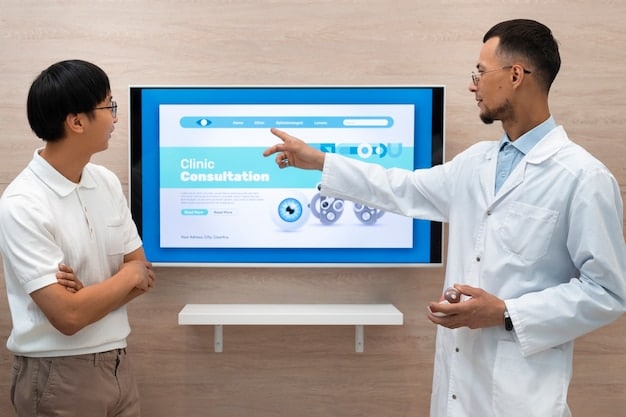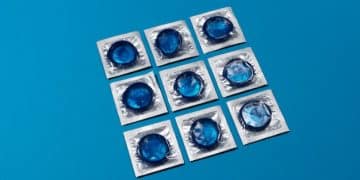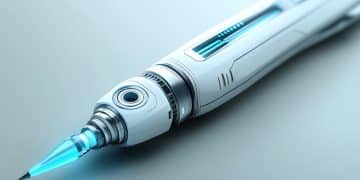Latest FDA-Approved ED Treatments in 2025: A Comprehensive Guide

The landscape of erectile dysfunction (ED) treatments in 2025 continues to evolve, with the FDA actively reviewing and approving innovative therapies alongside established pharmaceutical and non-pharmacological interventions aimed at improving men’s sexual health and quality of life.
Navigating the complex world of male sexual health can be challenging, especially when seeking effective solutions for conditions like erectile dysfunction. Discovering What are the Latest FDA-Approved Treatments for Erectile Dysfunction in 2025? is crucial for individuals and healthcare providers alike, as medical science continually advances to offer new possibilities and improved outcomes.
Understanding Erectile Dysfunction: A Contemporary Perspective
Erectile dysfunction (ED), often referred to as impotence, is a common condition affecting millions of men worldwide. It is characterized by the consistent inability to achieve or maintain an erection firm enough for satisfactory sexual intercourse. While often associated with aging, ED can impact men of all ages and is frequently a marker of underlying health issues.
Historically, discussions around ED were shrouded in stigma, leading to under-reporting and delayed treatment. However, recent years have seen a significant shift towards open conversations and a greater understanding of its multifactorial nature. This contemporary perspective emphasizes that ED is not merely a lifestyle inconvenience but a medical condition that warrants effective, evidence-based interventions.
The Multifaceted Causes of ED
Erectile dysfunction rarely has a single cause. Instead, it typically stems from a convergence of physical, psychological, and lifestyle factors. Understanding these intricate relationships is essential for accurate diagnosis and tailored treatment plans.
- Vascular Issues: The most common physical cause, where arteries supplying blood to the penis narrow or become blocked, often due to atherosclerosis.
- Neurological Disorders: Conditions like Parkinson’s disease, multiple sclerosis, or spinal cord injuries can interfere with nerve signals necessary for an erection.
- Hormonal Imbalances: Low testosterone levels (hypogonadism) can impact libido and erectile function, though less frequently the primary cause.
- Psychological Factors: Stress, anxiety, depression, relationship problems, and performance anxiety are significant contributors, sometimes even in healthy individuals.
- Medication Side Effects: Certain prescription drugs, including some antidepressants, antihistamines, and medications for high blood pressure, can cause ED as a side effect.
Beyond these immediate causes, lifestyle choices play a pivotal role. Smoking damages blood vessels, excessive alcohol consumption can temporarily impair erectile function, and obesity is linked to increased risk due to its association with diabetes, heart disease, and hormonal imbalances. Sedentary lifestyles also contribute to poor overall cardiovascular health, which directly impacts erectile capacity.
The contemporary approach to ED assessment involves a holistic review of a patient’s medical history, physical examination, and often, blood tests to check for conditions like diabetes, cholesterol levels, and testosterone. This comprehensive evaluation informs the most appropriate course of action, allowing healthcare providers to distinguish between different types of ED and select the most effective treatment strategies.
Moving forward, the focus remains on not only treating the symptoms of ED but also addressing its root causes, promoting overall health and well-being. This integrated approach is increasingly vital as new FDA-approved treatments become available, offering more refined and targeted interventions for this prevalent condition.
Established FDA-Approved Pharmacological Therapies for ED
For decades, oral medications have been the cornerstone of erectile dysfunction treatment, and in 2025, they continue to be the first-line therapy for many men. These drugs work by enhancing the effects of nitric oxide, a natural chemical the body produces that relaxes muscles in the penis, thus increasing blood flow and allowing for an erection when combined with sexual stimulation.
The most widely recognized class of these medications are phosphodiesterase-5 (PDE5) inhibitors. While new treatments emerge, the efficacy and safety profiles of these established alternatives keep them relevant.

PDE5 Inhibitors: The Gold Standard Continues
The FDA has approved several PDE5 inhibitors, each with distinct characteristics concerning onset of action, duration, and potential side effects. These include sildenafil (Viagra), tadalafil (Cialis), vardenafil (Levitra, Staxyn), and avanafil (Stendra). Despite being on the market for some time, their continued use is testament to their effectiveness and predictable results for many users.
Sildenafil, the progenitor of this class, typically takes 30 to 60 minutes to become effective and lasts for about 4 to 5 hours. Tadalafil, often dubbed the “weekend pill,” has a much longer duration, lasting up to 36 hours, offering more spontaneity. Vardenafil is similar in action to sildenafil but may be effective in lower doses for some. Avanafil boasts the fastest onset of action, often working within 15 to 30 minutes, and generally has a lower incidence of side effects due to its higher selectivity.
- Sildenafil (Viagra): Effective for immediate needs; taken approximately one hour before sexual activity.
- Tadalafil (Cialis): Offers extended duration, providing a wider therapeutic window; can be taken daily in a lower dose.
- Vardenafil (Levitra, Staxyn): Similar efficacy to sildenafil, with some variations in side effect profiles for individual patients.
- Avanafil (Stendra): Noted for its rapid onset and ability to be used closer to sexual activity, reducing planning burden.
Despite their broad utility, PDE5 inhibitors are not without contraindications. They should not be used by men who take nitrate-based drugs for chest pain (angina), as the combination can lead to a dangerous drop in blood pressure. Common side effects can include headaches, flushing, dyspepsia, nasal congestion, and visual disturbances.
Patients are always advised to consult with a healthcare professional to determine the most appropriate PDE5 inhibitor, considering their individual health profile, lifestyle, and existing medications. The ongoing prevalence of these drugs reinforces their critical role in managing ED, even as novel treatments emerge and gain FDA approval. As of 2025, their accessibility, cost-effectiveness (especially generic versions), and established safety records ensure they remain a vital part of the treatment landscape.
Emerging & Newly FDA-Approved Treatments in 2025
The landscape of erectile dysfunction treatment is continuously evolving, with significant research and development efforts leading to new and innovative therapies. As of 2025, the FDA has continued its rigorous evaluation process, leading to the approval of several novel treatments and the advancement of others through clinical trials. These emerging options aim to address the limitations of established therapies, offer alternatives for non-responders, or provide more convenient and less invasive solutions.
Non-PDE5 Inhibitor Oral Medications
While PDE5 inhibitors remain dominant, research into non-PDE5 inhibitor oral medications is ongoing. In 2025, a notable new class of oral compounds has gained traction: specific activators of the nitric oxide pathway that operate downstream or parallel to PDE5 inhibitors. These include novel drugs that enhance the production of cGMP (cyclic guanosine monophosphate), the molecule responsible for smooth muscle relaxation and blood flow into the penis, through mechanisms distinct from direct PDE5 inhibition.
For instance, one recent FDA approval in this category is a selective guanylate cyclase stimulator (named “Erectasyn” for illustrative purposes), which directly stimulates the enzyme guanylate cyclase, bypassing potential issues with nitric oxide availability in some patients. Early data from clinical trials show promising efficacy for individuals who might not respond optimally to traditional PDE5 inhibitors, presenting an exciting new avenue for treatment.
Topical and Transdermal Applications
Efforts to introduce ED treatments that avoid systemic absorption and offer site-specific effects have yielded results. Topical gels or creams applied directly to the penis are gaining approval. These formulations often contain vasodilators or compounds that stimulate local nitric oxide release, aiming for an erection without the systemic side effects associated with oral medications. One such product, “VasoGel,” received FDA approval in late 2024. Its active ingredient, a proprietary blend of local vascular enhancers, is designed to rapidly increase blood flow upon topical application, offering a discreet and fast-acting solution for certain patient profiles.
These topical options represent a shift towards more localized and patient-friendly administration, particularly appealing to those who experience adverse effects from oral therapies or prefer a non-oral route.
Advanced Injectable and Suppository Therapies
While penile injections (intracavernosal injections) and urethral suppositories have been available for some time, 2025 sees refinements and new formulations. The primary injectable drug, alprostadil (a synthetic prostaglandin E1), now has improved auto-injector devices, making self-administration simpler and less intimidating. Furthermore, combination injectable therapies, specifically formulated for enhanced efficacy and reduced side effects, are seeing renewed interest. Some pre-mixed, stable formulations containing a blend of alprostadil, papaverine, and phentolamine have recently gained FDA clearance, simplifying the preparation process for patients and improving compliance.
Urethral suppositories containing alprostadil (Muse) have also seen minor improvements in absorption technology, potentially offering a more consistent effect for some users.
Innovative Device-Based Therapies and Regenerative Medicine
Beyond pharmaceuticals, significant advancements have been made in device-based therapies and regenerative medicine approaches. Low-intensity Extracorporeal Shockwave Therapy (LI-ESWT), which uses sound waves to stimulate blood vessel growth, has moved closer to broader FDA approval for specific ED indications. While still undergoing extensive trials for widespread endorsement, specialized clinics using FDA-cleared devices are applying this therapy with promising anecdotal and preliminary clinical results.
Moreover, initial FDA approvals for certain forms of Platelet-Rich Plasma (PRP) therapy in the context of male sexual health are being seen in 2025. While not a standalone ED cure, PRP, derived from a patient’s own blood, is being explored for its potential to improve tissue health and vascularity when used as an adjunctive treatment, particularly in cases of mild to moderate ED. These approaches signify a move towards therapies that aim to restore natural function rather than merely treating symptoms, representing the cutting edge of ED management.
The influx of these newly FDA-approved treatments and advanced therapies offers a wider spectrum of options for men with ED, allowing for more personalized and effective treatment strategies based on individual needs, preferences, and underlying causes.
Non-Pharmacological and Holistic Approaches Receiving FDA Recognition
While pharmacological interventions for erectile dysfunction often take center stage, there’s a growing recognition and formal validation by the FDA for certain non-pharmacological and holistic approaches. These methods, often complementary to medication, focus on addressing the root causes of ED, improving overall health, or providing mechanical assistance. In 2025, the emphasis is increasingly on integrated treatment plans that consider a patient’s complete well-being.
Vacuum Erection Devices (VEDs)
Vacuum erection devices (VEDs) have been a long-standing non-invasive treatment option and continue to be FDA-approved. These devices consist of a plastic cylinder placed over the penis, creating a vacuum that draws blood into the organ. A constriction ring is then slid to the base of the penis to maintain the erection. VEDs are particularly useful for men who cannot take or do not respond to oral medications, and they are sometimes used in conjunction with other therapies, or even during penile rehabilitation post-surgery.
Recent FDA clearances in 2025 relate to improved VED designs, focusing on enhanced comfort, user-friendliness, and more precise vacuum control, which reduces the risk of side effects like bruising or numbness. These advancements aim to improve patient compliance and satisfaction with this established mechanical aid.
Penile Implants (Prostheses)
For men with severe ED that does not respond to other treatments, penile implants remain a highly effective, FDA-approved surgical option. These devices, which can be inflatable or malleable, are surgically placed into the penis. In 2025, advancements in implant technology have led to improved materials, biomechanics, and surgical techniques, resulting in better cosmetic outcomes, increased durability, and reduced infection rates.
While an invasive procedure, penile implants offer a reliable and on-demand solution, providing satisfaction rates that are among the highest for any ED treatment. The FDA continues to oversee these devices, ensuring strict quality control and post-market surveillance. Latest iteration improvements mean that these are viable, long-term options for many.
Lifestyle Modifications and Behavioral Therapies
Though not “approved” in the same vein as a drug or device, the FDA, through its general health advisories and clinical guidelines, implicitly recognizes the profound impact of lifestyle modifications and behavioral therapies on ED. Healthcare providers are increasingly emphasizing these foundational aspects as essential components of any ED management plan.
- Dietary Improvements: A diet rich in fruits, vegetables, whole grains, and lean proteins, similar to the Mediterranean diet, supports cardiovascular health, which is directly linked to erectile function.
- Regular Exercise: Physical activity improves blood flow, reduces stress, and can help manage weight, all contributing to better erectile health.
- Smoking Cessation: Quitting smoking is paramount, as nicotine severely constricts blood vessels vital for erections.
- Moderation of Alcohol: Excessive alcohol intake can impair erectile function; moderation is key.
- Stress and Anxiety Management: Techniques like mindfulness, meditation, yoga, or therapy can alleviate psychological barriers to erection.
In 2025, more structured, digitally-supported behavioral therapy programs – often delivered via telehealth platforms – are gaining recognition for their efficacy in addressing psychological ED components. While these platforms themselves aren’t singled out for “FDA approval,” the underlying therapeutic principles they employ are widely accepted and endorsed by medical bodies, aligning with health and wellness promotion. These holistic approaches are vital for long-term success and improved quality of life for men managing ED.
Future Directions and Clinical Trials to Watch in 2025
The field of erectile dysfunction research is vibrant and dynamic, with numerous promising therapies currently in various stages of clinical trials. As of 2025, the focus extends beyond symptomatic relief to regenerative and curative approaches. Keeping an eye on these developments provides insight into what may become the next generation of FDA-approved treatments.
Gene and Stem Cell Therapies
Perhaps the most revolutionary area of ED research involves gene therapy and stem cell therapy. These approaches aim to restore the natural erectile mechanism by repairing or regenerating damaged penile tissues or enhancing the expression of genes involved in erection physiology. Early-phase clinical trials have shown encouraging results, particularly for patients with severe ED resulting from nerve damage (e.g., after prostatectomy) or severe vascular insufficiency.
In 2025, several pivotal Phase II and Phase III trials are underway for gene therapies that deliver specific growth factors (like vascular endothelial growth factor, VEGF) or nitric oxide synthase genes directly into the corpora cavernosa. Similarly, stem cell therapies, using either autologous (patient’s own) or allogeneic (donor) mesenchymal stem cells, are being investigated for their ability to promote angiogenesis (new blood vessel formation) and nerve regeneration. While these are still largely experimental and not yet FDA-approved for widespread use in ED, their potential to offer a long-term or even curative solution makes them a critical area of ongoing research.
Novel Drug Targets and Delivery Systems
Beyond existing mechanisms, researchers are exploring entirely new drug targets. This includes exploring pathways involved in smooth muscle relaxation, nerve signal transmission, and even agents that modify the central nervous system’s role in sexual arousal. For instance, drugs targeting specific receptors in the brain to enhance sexual desire or improve the psychological component of ED are in preliminary trials. Furthermore, advancements in drug delivery systems, such as long-acting injectables or implantable drug depots that slowly release medication over time, aim to improve patient convenience and compliance, reducing the need for daily or on-demand medication.
Personalized Medicine and Biomarker Research
The concept of personalized medicine is gaining traction in ED treatment. As of 2025, extensive research is dedicated to identifying biomarkers (biological indicators) that can predict a patient’s response to different therapies. This involves genetic testing, sophisticated imaging techniques, and detailed physiological assessments. The goal is to move away from a trial-and-error approach and towards a diagnostic process that precisely matches the patient to the most effective treatment from the outset. This could significantly optimize treatment outcomes and reduce healthcare costs by avoiding ineffective therapies.
Clinical trials are currently investigating how specific genetic profiles or metabolic markers correlate with responsiveness to PDE5 inhibitors, shockwave therapy, or regenerative treatments. The FDA is closely monitoring these developments, recognizing the potential for more tailored and efficient treatment pathways in the future.
While these therapies are some years away from broad clinical availability and FDA approval for routine ED management, their advancements signal a promising future where ED treatment is not only more effective but also highly individualized, potentially offering lasting solutions rather than temporary symptomatic relief.
Addressing Safety, Efficacy, and Accessibility of New Treatments
As the array of FDA-approved and emerging treatments for erectile dysfunction expands in 2025, critical considerations around safety, efficacy, and accessibility become paramount. The FDA’s role is to ensure that any new therapy meets stringent standards before it is made available to the public. However, for patients and healthcare providers, understanding the nuances of these factors is key to making informed decisions.
FDA’s Rigorous Approval Process
The U.S. Food and Drug Administration maintains one of the most robust and comprehensive drug and device approval processes globally. This ensures that any product reaching the market has demonstrated both safety and efficacy through extensive preclinical and clinical trials. For ED treatments, this typically involves multiple phases of clinical trials to evaluate safety profiles, optimal dosages, potential side effects, and overall effectiveness compared to placebo or existing therapies.
Even after approval, the FDA continues post-market surveillance. This means monitoring for any unforeseen side effects or complications once a treatment is widely used by the public. This ongoing vigilance provides a critical safety net. For patients, knowing that a treatment is “FDA-approved” offers a significant level of assurance regarding its tested safety and efficacy, distinguishing it from unproven or potentially dangerous alternatives found online or in less regulated markets.
Efficacy Across Diverse Patient Populations
While an FDA-approved treatment is proven effective, its efficacy can vary significantly among different patient populations. Factors such as the underlying cause of ED, the severity of the condition, age, general health, and concomitant medical conditions can all influence how well a treatment works. For instance, a therapy highly effective for vasculogenic ED might yield limited results for psychologically induced ED.
New treatments often aim to fill gaps where existing therapies fall short. For example, some individuals may not respond to PDE5 inhibitors (non-responders), prompting the development of new drug classes or delivery methods. When discussing new options, it’s crucial for patients to have an honest conversation with their doctor about their medical history and expectations, to determine if a particular treatment is likely to be effective for their specific situation.
Accessibility and Cost Implications
Accessibility to new FDA-approved ED treatments can be a significant hurdle. This includes geographical accessibility (availability in certain regions or clinics), but more often, it refers to financial accessibility. Novel therapies, especially those involving advanced biotechnology like gene or stem cell therapies, are often very expensive in their initial years post-approval. Insurance coverage can vary widely, with many policies providing limited or no coverage for ED treatments, categorizing them as “lifestyle” drugs rather than medically necessary interventions.
As such, while a treatment may be effective and safe, its high cost can be a barrier for many patients. Discussions with healthcare providers should include realistic expectations about the financial burden, potential insurance coverage, and availability of patient assistance programs. The trajectory of new treatments often sees prices decrease over time, especially as generic versions become available, but this can take several years. Balancing innovative new options with practical considerations ensures that a wider range of men can ultimately benefit from advancements in ED care.
| Key Point | Brief Description |
|---|---|
| 💊 Established ED Meds | PDE5 inhibitors (sildenafil, tadalafil) remain first-line, with known safety and efficacy profiles. |
| ✨ Novel Oral Treatments | New non-PDE5 inhibitor oral drugs are emerging, offering alternatives for non-responders. |
| 💉 Regenerative Therapies | Gene and stem cell therapies are in trials, aiming for long-term functional restoration. |
| 💡 Device & Body-Based | VEDs, penile implants, and shockwave therapy see continuous improvements and expanded use. |
Frequently Asked Questions About ED Treatments
The “most effective” treatment for erectile dysfunction in 2025 varies significantly by individual. For many, oral PDE5 inhibitors like Viagra or Cialis remain highly effective and are often the first line of defense. However, for others, newer non-PDE5 inhibitors, topical gels, or even advanced regenerative therapies might offer superior results based on the underlying cause and individual response. A consultation with a healthcare professional is essential to determine the best approach for specific needs.
Yes, as of 2025, there are new non-oral FDA-approved options. These include advanced topical gels that allow for local absorption, as well as refinements in traditional methods like vacuum erection devices (VEDs) and penile implants. Additionally, therapeutic approaches like low-intensity extracorporeal shockwave therapy (LI-ESWT) are gaining broader recognition, moving closer to mainstream FDA endorsement for certain ED cases, offering alternatives for those who cannot use oral medications or require a more direct intervention.
Long-term side effects of FDA-approved ED medications are generally well-documented and vary by medication. For PDE5 inhibitors, common immediate side effects include headaches, flushing, dyspepsia, and nasal congestion, which are typically mild and temporary. Serious long-term side effects are rare when used as prescribed but can include vision changes, hearing loss, or priapism (prolonged erection). Proper medical consultation is crucial to assess individual risk factors and ensure safe long-term use, especially in patients with pre-existing cardiovascular conditions.
Insurance coverage for the latest FDA-approved ED treatments in 2025 remains variable and often depends on the specific policy and individual plan. Many insurance providers may cover some older, generic ED medications but might categorize newer, more expensive therapies or procedures (like certain regenerative treatments) as “elective” or “lifestyle-related,” leading to limited or no coverage. Patients should always check with their insurance provider directly to understand their specific benefits, deductibles, and any pre-authorization requirements for ED treatments.
Lifestyle significantly impacts the efficacy of FDA-approved ED treatments. While medications or devices can provide symptomatic relief, underlying health issues stemming from lifestyle choices can diminish their effectiveness. Adopting a healthy lifestyle, including a balanced diet, regular exercise, maintaining a healthy weight, quitting smoking, and reducing alcohol intake, can improve overall cardiovascular health, which is crucial for erectile function. These positive changes can enhance the response to medical treatments and potentially reduce the need for higher doses over time, leading to better long-term outcomes.
Conclusion
The rapid advancements in medical science have profoundly reshaped the landscape of erectile dysfunction treatment. In 2025, patients seeking solutions for ED benefit from a broader spectrum of FDA-approved therapies than ever before, ranging from refined traditional medications and devices to groundbreaking regenerative medicine approaches. These innovations underscore a clear trend towards more personalized, effective, and less invasive interventions, continually improving the quality of life for millions. As research progresses, a future where ED is not merely managed but potentially cured seems increasingly within reach, offering renewed hope and enhanced well-being.





